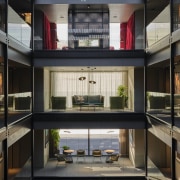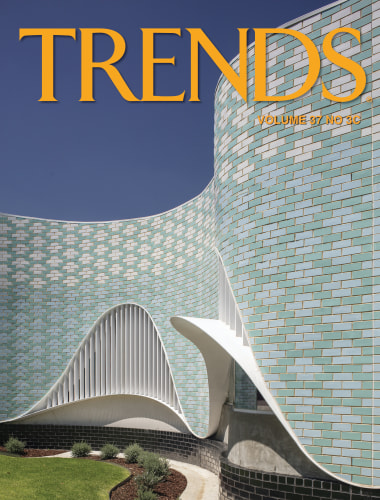The hotel that celebrates its city
With a facade that artistically evokes the City of Dunedin's first discovery and literally reflects key heritage buildings, Ebb – Dunedin also has an airy, social atrium that connects hotel guests with retail and business on its doorstep
Within a relatively short time of opening, Ebb – Dunedin designed by Gary Todd Architecture has already attracted 50% repeat business – a major statistical success story; and the inner-city hotel has also been welcomed onto an arts trail by the Dunedin City Council, a major and surprising achievement for any commercial building.
These facts alone reflect Ebb’s close connection to its beloved city of Dunedin – a connectivity that’s celebrated in everything from its unique artistic façade, to its historically significant location, and open piazza-like internal architecture.
The building and its relationship to the city
The brief was to address the best use for a site located between retail, residential and heritage zones.
The client was considering residential apartments with car parking that could be sold for quick investment return, however was open to other options that could provide a greater long term return, such as a hotel.
A boutique hotel was eventually considered the most desirable development to interface with existing residential or retail buildings and the public realm and to contribute to city urban vibrancy.
The client also had an interest in art and sought to have this included in the building – a factor that was to drive one of the hotel’s major points of difference.
And equally importantly, an evocation of Dunedin’s history was to be woven into the design, or as architect Gary Todd says: “I think architecture can be used as a narrative to tell a story.”
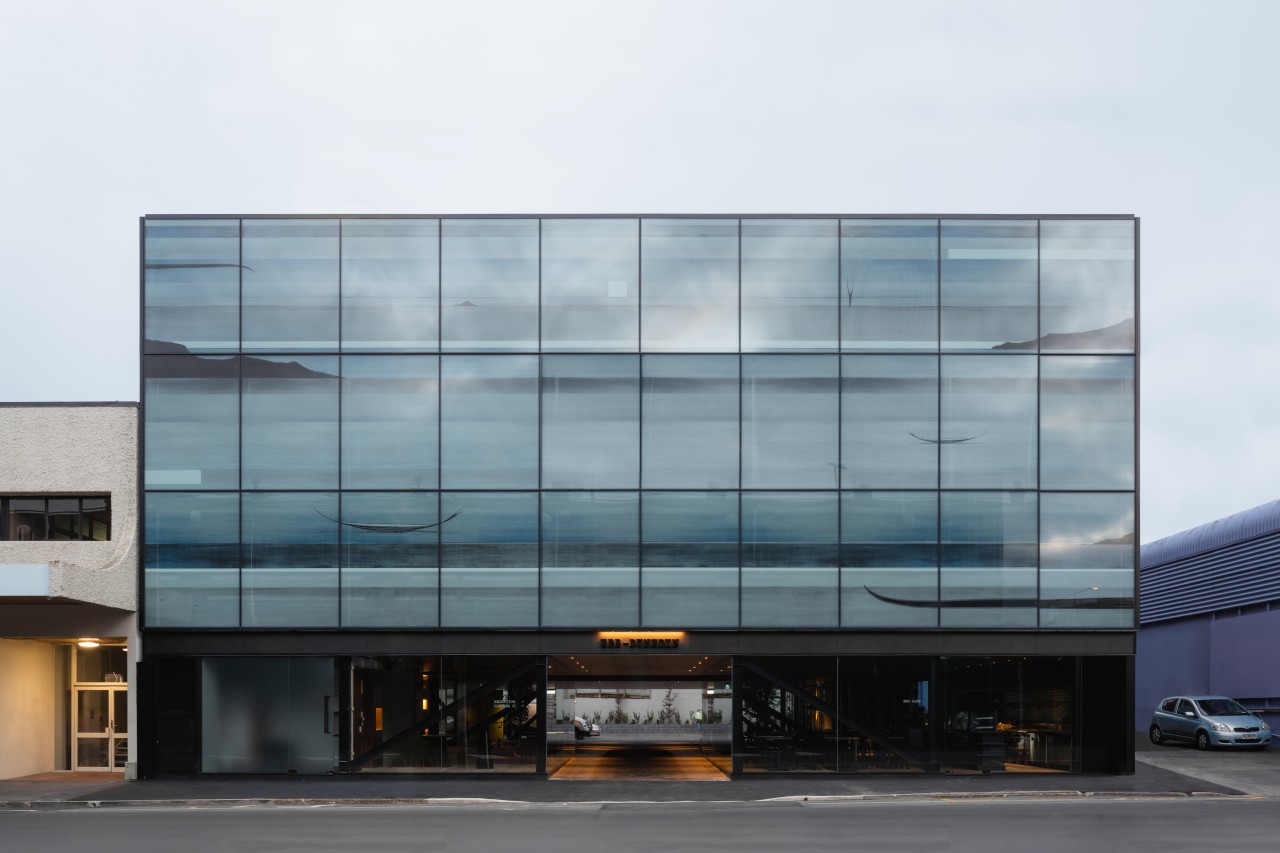
However, while the site was evocative historically it came with initial limitations.
“With most commercial projects, you want to maximise your investment on the site, so the challenge for us was that it was a narrow site, and that it did have height restrictions on it,” says Todd.
“We applied for a resource consent to add an additional storey because it was more economic to put another storey of hotel accommodation onto the site.
“In terms of the height of the building we related to the taller scale seen across the road, as the large retail building was actually a few storeys higher than ours. So we felt that the building could have its own identity more in context with the wider streetscape.
"And that was approved as a non-notified application because it was considered that no parties were affected for a better outcome.”
A façade that does justice to the setting
Contextual research revealed the site was once near the shoreline of the Otago Harbour when the first sea travellers discovered Dunedin by waka. Of course, land reclamation has since stretched the city out to the shoreline it enjoys today.
“So not far away from the site is where the canoes were pulled up on the shoreline at George Street, the next block basically – within a couple of 100 metres of where Ebb – Dunedin stands today,” says Todd.
To reference this significant historical site, local artist Simon Kaan was engaged to provide an image to visually portray a cultural heritage context of the location and reflect a sense of place.
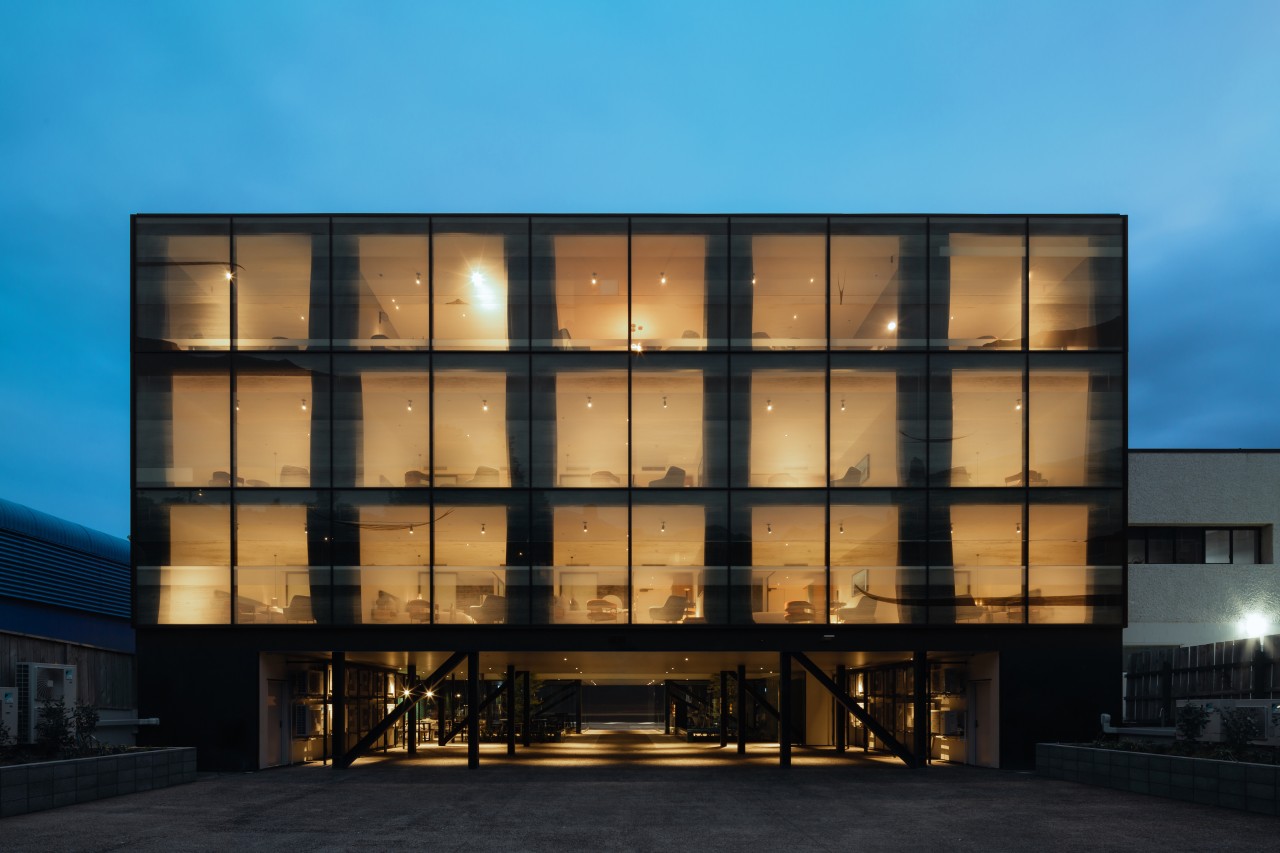
The contemporary interpretive artwork covers the hotel’s glass-front and rear facade and conveys a Dunedin theme of land, sea and sky, and features an impression of arriving wakas on misty water. The artwork is also printed onto the atrium glass north wall of the building.
In addition, both glass façades – comprised of thirty panels – literally reflects the heritage buildings across the road, plus those behind, acknowledging more recent decades of the city’s rich history.
The evocative, semi-transparent printed glass facade also fulfils a pragmatic role in that it screens some views from within the hotel while providing privacy to guests.
The façade contributes in yet another way, too.
Lifted on exposed steel beams to floating effect, the glazed hotel frontage is a giant, restful artwork in its own right – a sign of things to come for the hotel’s artwork-hung internal walkways and an elegant modern counterpoint to older neighbouring retail buildings.
Below the giant artwork façade, the clear-glass-fronted hotel reception and café together with the hotel’s exposed steel structure creates an activated ground-level street face that invites you in to the central open atrium – the other major point of difference for the forward looking and historically evocative hotel.
Come evening, the façade is activated in a different way – taking on a translucent quality, with internal movements seen in silhouette, the level of translucence gauged to ensure guest privacy.
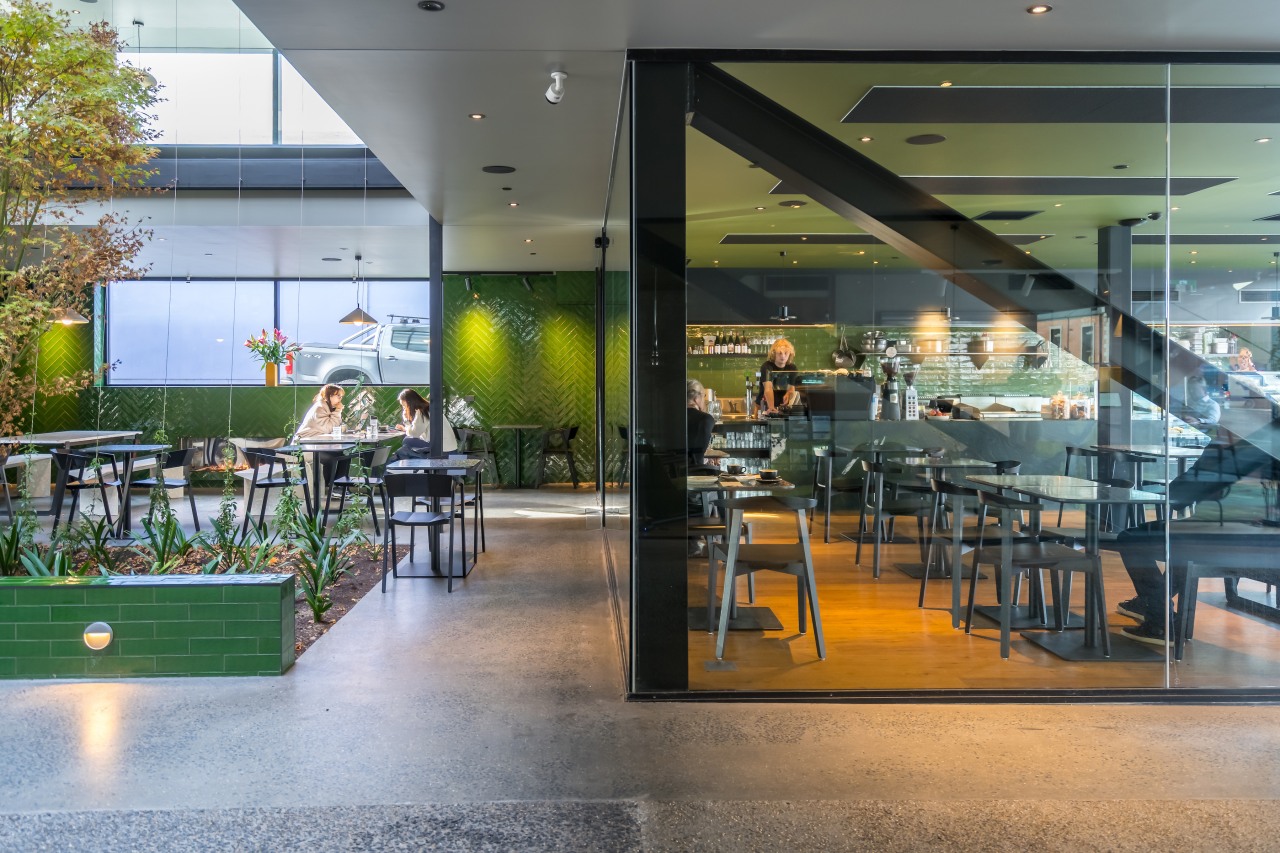
The atrium – the warmth and connection of a European piazza-oriented town
Above the concrete base, the hotel’s exposed steel structures are visible through clear glazed walls at street level.
This transparency at street level activates the reception, café and court to the public realm of city life.
These spaces in turn revolve around a central atrium that extends four storeys up to a louvred roof. At ground level there is an engaging, light-filled courtyard with horizontal and vertical gardens.
“The upper suites and open spaces above are arranged around the central atrium sort of like a little European town where the piazza is able to be looked down on from the privacy and safety of surrounding homes with verandas and balconies above."
And as well as providing an inviting hub for local business people and hotel guests, the atrium also offers an invitation to not just stay in your room but rather to step into the atrium and then out into the colour and variety of the city.
You could say the atrium is like a lung that breaths in the city air. It is an invigorating airy space to pause in and pass through.
“This is a location ideally situated for walking out and exploring the city,” says Todd. “You can either walk up into the residential heritage behind the hotel, or along the retail zone, or you can walk to the CBD, or if you continue walking, you'll get to the harbour.
“And also you have the town hall and the Octagon at the end of the street – essentially the heart of the city.”
The sheltered atrium is open, protected from rain by operable roof louvres, but with the sunlight, breezes, gardens and activation of the guests coming and going, it can be hard to tell if you are actually indoors or out.
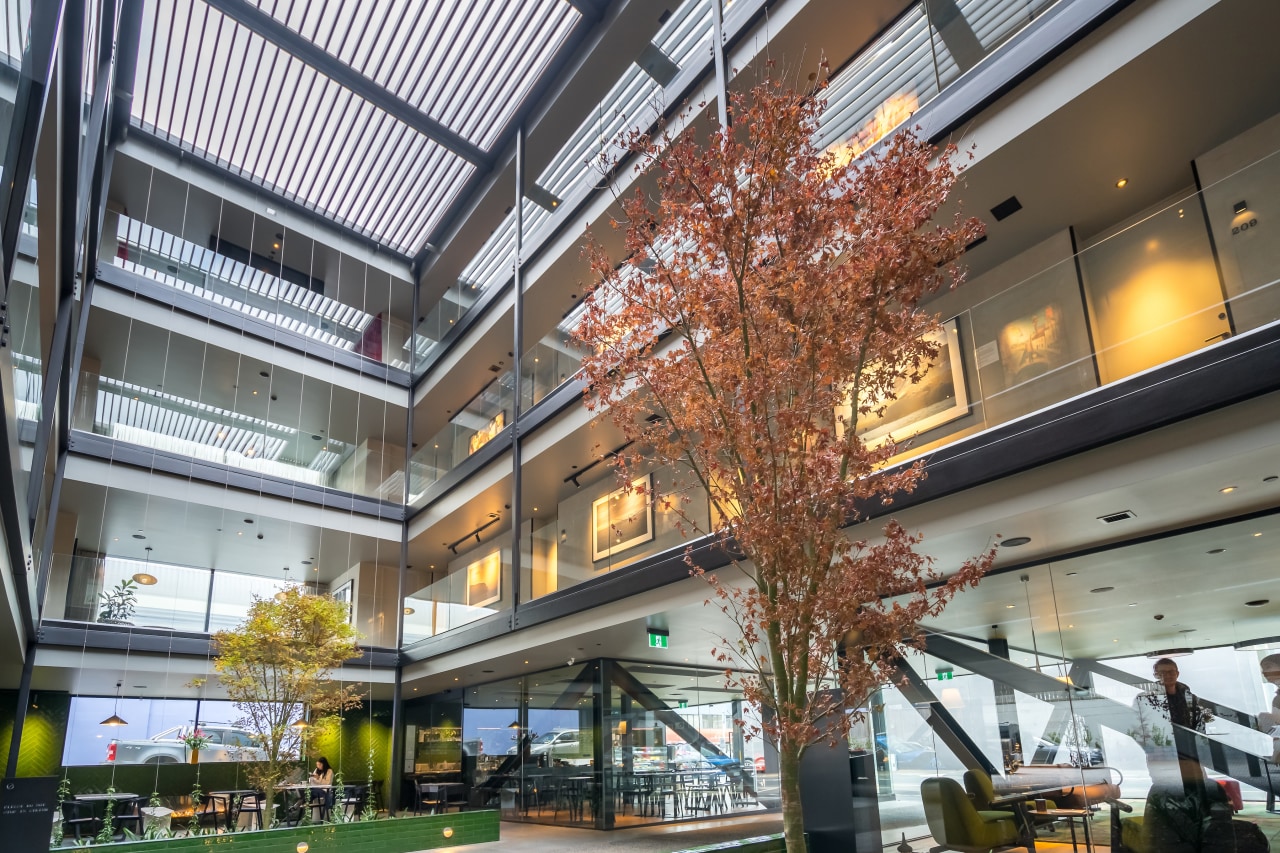
In addition, the individualistic spatial design means the mezzanine gallery walkways are also enjoyed by looking up from the café courtyard and reception, adding to the ambience of what is essentially a social hub for hotel guests and visitors alike.
“The cafe is a really good meeting place for locals and visitors going to the hotel for business. So there are a lot of meetings that actually happen in the café and atrium court.”
The wider interior architecture – private and community-focussed by degrees
The three upper levels are private hotel suites connected by balcony walkways and lounges that overlooking the atrium void, with a lift and stair access.
An outdoor lounge for hotel guests to the north has a printed glass façade providing filtered light and shadow through the atrium.
The building layout offers clear way finding within the hotel with walkway walls on these levels acting as an art gallery featuring works by Dunedin and New Zealand artists, some of which reference the printed art on the glass wall facades.
The hotel suites are positioned to surround the atrium with flexibility for intimacy or openness – to allow guests to indulge in private entertainment within the suites or engage in a wider connection via the various mezzanine lounges.
Much as the hotel dissolves into the city environment at street level, so the refined interior architecture blurs the line between the private and public upstairs spaces – the product of a collaboration between New Zealand and Australian architects and designers.
A Modernist aesthetic in an old part of town
Focussed on strong, simple lines, the hotel is designed as a Modernist building in concrete, steel and glass with a scale considerate to heritage commercial and residential buildings adjacent. At the same time it employs Iconic Dunedin Basalt and Oamaru stone which is used to inform a robust palette of interior materials.
It is perhaps no surprise that Gary Todd is a big fan of the Guggenheim Museum in New York, a decidedly Modernist building with an open heart and skylight above informing the ambience of the building interior.
The hotel’s interior architecture of steel, concrete, tile, and glass is carried through to the luxurious interior fit outs in terrazzo, ribbed glass, brass fittings, and bespoke furniture of timber and glass on steel frames.
In addition, the interior palette highlights landscape shades of green and brown, sea and sky shades of blue and white.
Linen and velvet fabrics add a luxurious tactile aesthetic to contrast and complement the clean-lined contemporary interior architecture.
Green agenda
Sustainability features incorporated into the design include high quality, durable materials, high thermal envelope insulation, acoustic double glazing and low-energy, long-life LED lighting, plus locally sourced produce including wine for the café and suites.
Credit list
Location
Interior architect, interior designer, kitchen and bathroom design
Floor area
Engineer
Plumber
Concrete supplier
Lighting designer
Downpipes
Framing and trusses
Windows
Paints
Interior artworks
Lead architects
Size
Construction, kitchen manufacturer, joiner
Electrical
Painter
Landscape construction
Roof
External walls
Cladding
Skylights
Facade artwork
Designed by: Gary Todd, Gary Todd Architecture
Story by: Trendsideas
Photography by: Jeremy Hooper, Studio South; Gareth Harvey, Gareth Harvey Photo & Video
Home kitchen bathroom commercial design
At one with the Amazon
Contrast and connection
Masculine meets mixed use

